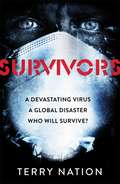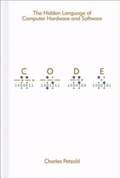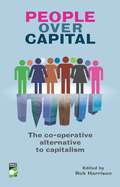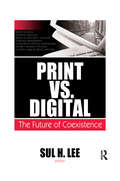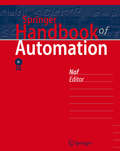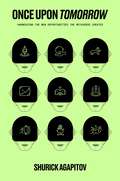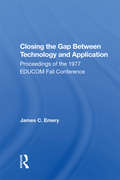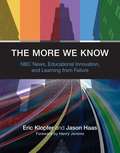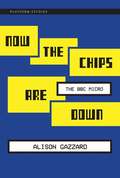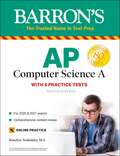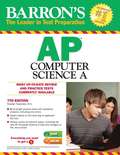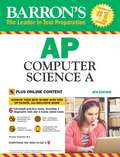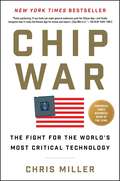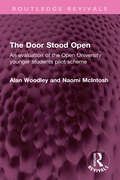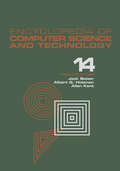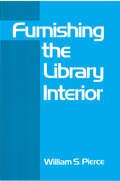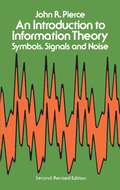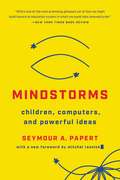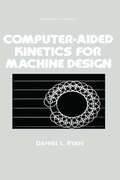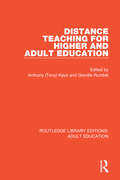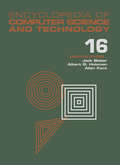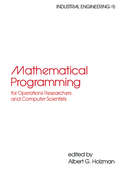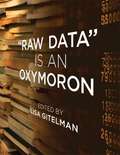- Table View
- List View
Survivors: The gripping, bestselling novel of life after a global pandemic
by Terry NationSurvivors of a global plague battle for life on an empty planet. A gripping vision of a post-apocalyptic world...'A fine piece of British post-apocalyptic fiction' 'Nation's novel is based on his original cult series...and is all the better for it, being far, far more gritty and realistic' SUNDAY SUNA virus has wiped out 95 per cent of the world's population in just a few weeks, leaving the remaining 5 per cent to stay alive in a world devoid of the most basic amenities - electricity, transport and medicine. The few survivors of the human race are forced to fall back on the most primitive skills in order to live and re-establish some semblance of law and order.Abby Grant, widowed by the plague, moves through this new dark age with determination, sustained by hope that her son, who fled his boarding school at the onset, has survived. She knows she must relearn the skills on which civilisation was built. With others, she founds a commune and the group return to the soil. But marauding bands threaten their existence. For Abby, there's a chance for a new life and love when she encounters James Garland, the fourteenth Earl of Woodhouse, who is engaged in a desperate fight to save his ancestral home. But more important, she must find her son.
Code: The Hidden Language of Computer Hardware and Software
by Charles PetzoldWhat do flashlights, the British invasion, black cats, and seesaws have to do with computers? In CODE, they show us the ingenious ways we manipulate language and invent new means of communicating with each other. And through CODE, we see how this ingenuity and our very human compulsion to communicate have driven the technological innovations of the past two centuries. Using everyday objects and familiar language systems such as Braille and Morse code, author Charles Petzold weaves an illuminating narrative for anyone who's ever wondered about the secret inner life of computers and other smart machines. It's a cleverly illustrated and eminently comprehensible story--and along the way, you'll discover you've gained a real context for understanding today's world of PCs, digital media, and the Internet. No matter what your level of technical savvy, CODE will charm you--and perhaps even awaken the technophile within.
People Over Capital
by Rob HarrisonCapitalism is failing and ordinary people are forced to pay the price. With such deep-rooted problems there is real hunger for alternative ways of organizing our economic system. Answering the question, "Is there a co-operative alternative to capitalism?" this book showcases fourteen responses from economists, academics, co-operators, politicians, and campaigners, exploring both the success and untapped potential of co-operatives. Each essay approaches from a new direction-from the flourishing open source movement to cases of co-operative success in different parts of the world.Rob Harrison has written and commented widely on social change issues for more than twenty years.
Print vs. Digital: The Future of Coexistence (Monographs From The Journal Of Library Administration Ser.)
by Sul H. LeeLibraries are currently confronted by the challenges of managing increasing amounts of electronic information. Print vs. Digital: The Future of Coexistence presents the expert perspectives of eight of America’s leading library administrators on ways to effectively manage digital flow and offers strategies to provide a level of coexistence between digital and print information. This excellent overview explores how to best balance print and electronic resources, and explores important issues such as the selection of electronic resources, improving access to digital information for a larger user base, and effective management of a library’s fiscal and personnel resources. Print vs. Digital: The Future of Coexistence discusses the various challenges libraries now face from the massive influx of digital resources, including the ways that information-seeking behaviors have changed, the search for synergies between print and digital, economics of news preservation, and whether or not the end of print journals is at hand. New ideas and technological advances are explored, including the diverse ways these improvements will impact the future. This well-referenced resource includes useful tables, figures, and photographs. Topics in Print vs. Digital: The Future of Coexistence include: cooperative collection development balance of print and electronic resources evolvement of digital resources in libraries change in research libraries factors influencing the selection of electronic resources disseminating information about scholarly collections impact of digital resources on research behavior and techniques design of digital libraries JSTOR effects of digital information on reference collections transition of print journals to digital formats Print vs. Digital: The Future of Coexistence is a thought provoking, insightful resource on the future of libraries, invaluable for acquisitions, reference, and collection development librarians; and senior and mid-level administrators such as deans, directors, and department heads for public, special, and academic libraries.
Springer Handbook of Automation
by Shimon Y. NofThis handbook incorporates new developments in automation. It also presents a widespread and well-structured conglomeration of new emerging application areas, such as medical systems and health, transportation, security and maintenance, service, construction and retail as well as production or logistics. The handbook is not only an ideal resource for automation experts but also for people new to this expanding field.
Once Upon Tomorrow: Harnessing the New Opportunities the Metaverse Creates
by Shurick AgapitovShurick Agapitov&’s Once Upon Tomorrow unpacks the sometimes vague concept of the metaverse and shares the opportunities that are and will be available within this new world.Thirty years ago, the advent of the internet changed the world. For the first time in human history, the collected knowledge of all mankind was freely available to every man, woman, and child on the planet with the click of a few buttons. Fifteen years ago, the world changed again with the widespread availability and adoption of smartphones that put the full power of the internet in the palm of our hands whenever we want and wherever we are. As monumental as these advancements were, they were just the warmup for the change that&’s coming next. In just a few years, we won&’t think of &“going on the internet&” to look up information and find entertainment. Instead, we&’ll already be in the internet, living, working, and playing in an endless virtual world that will turn everything we think we know about the internet on its head. Welcome to the Metaverse. In Once Upon Tomorrow, visionary tech CEO Shurick Agapitov dives deep into this new age of the internet by unpacking exactly what the Metaverse is and what it will become. It&’s not about pixels and computer chips; it&’s a total paradigm shift what will revolutionize how people interact, share stories, create and implement ideas, conduct business, and literally live their lives. The Metaverse will be the biggest change any of us have ever seen. Fortunately, Shurick Agapitov is here to take you by the hand and welcome you into this wild, wonderful new universe of opportunity.
Closing The Gap Between Technology And Application
by James C. EmeryThis book presents analyses, from three points of view, of the use of computing technology in higher education. It considers application areas including office automation, distributed academic computing, distributed administrative computing, instructional systems, and information resources.
The More We Know
by Eric Klopfer Jason HaasIn 2006, young people were flocking to MySpace, discovering the joys of watching videos of cute animals on YouTube, and playing online games. Not many of them were watching network news on television; they got most of their information online. So when NBC and MIT launched iCue, an interactive learning venture that combined social networking, online video, and gaming in one multimedia educational site, it was perfectly in tune with the times. iCue was a surefire way for NBC to reach younger viewers and for MIT to test innovative educational methods in the real world. But iCue was a failure: it never developed an audience and was canceled as if it were a sitcom with bad ratings. In The More We Know, Eric Klopfer and Jason Haas, both part of the MIT development team, describe the rise and fall of iCue and what it can teach us about new media, old media, education, and the challenges of innovating in educational media. Klopfer and Haas show that iCue was hampered by, among other things, an educational establishment focused on "teaching to the test," television producers uncomfortable with participatory media, and confusion about the market. But this is not just a cautionary tale; sometimes more can be learned from an interesting failure than a string of successes. Today's educational technology visionaries (iPads for everyone!) might keep this lesson in mind.
Now the Chips Are Down: The BBC Micro
by Alison GazzardIn 1982, the British Broadcasting Corporation launched its Computer Literacy Project, intended "to introduce interested adults to the world of computers and computing." The BBC accompanied this initiative with television programs, courses, books, and software -- an early experiment in multi-platform education. The BBC, along with Acorn Computers, also introduced the BBC Microcomputer, which would be at the forefront of the campaign. The BBC Micro was designed to meet the needs of users in homes and schools, to demystify computing, and to counter the general pessimism among the media in Britain about technology. In this book, Alison Gazzard looks at the BBC Micro, examining the early capabilities of multi-platform content generation and consumption and the multiple literacies this approach enabled -- not only in programming and software creation, but also in accessing information across a range of media, and in "do-it-yourself" computing. She links many of these early developments to current new-media practices. Gazzard looks at games developed for the BBC Micro, including Granny's Garden, an educational game for primary schools, and Elite, the seminal space-trading game. She considers the shift in focus from hardware to peripherals, describing the Teletext Adapter as an early model for software distribution and the Domesday Project (which combined texts, video, and still photographs) as a hypermedia-like experience. Gazzard's account shows the BBC Micro not only as a vehicle for various literacies but also as a user-oriented machine that pushed the boundaries of what could be achieved in order to produce something completely new.
Principles of Digital Communication and Coding (Dover Books on Electrical Engineering)
by Jim K. Omura Andrew J. ViterbiWritten by two distinguished experts in the field of digital communications, this classic text remains a vital resource three decades after its initial publication. Its treatment is geared toward advanced students of communications theory and to designers of channels, links, terminals, modems, or networks used to transmit and receive digital messages.The three-part approach begins with the fundamentals of digital communication and block coding, including an analysis of block code ensemble performance. The second part introduces convolutional coding, exploring ensemble performance and sequential decoding. The final section addresses source coding and rate distortion theory, examining fundamental concepts for memoryless sources as well as precepts related to memory, Gaussian sources, and universal coding. Appendixes of useful information appear throughout the text, and each chapter concludes with a set of problems, the solutions to which are available online.
AP Computer Science A: With 6 Practice Tests (Barron's Test Prep)
by Roselyn Teukolsky M.S.Barron&’s AP Computer Science A is completely up-to-date for the May 2020 exam changes. The course outline and free response questions reflect updates to the topics breakdown and free-response section. You&’ll get the key content review, practice tests, and effective strategies you need to be prepared for the exam. This edition features:Five full-length practice tests, including three onlineOne diagnostic test to help you determine which sections you need to focus onSpecific strategies for the AP Computer Science A examComprehensive content reviewGlossary of useful computer terms
Barron's AP Computer Science A: (Seventh Edition)
by Roselyn TeukolskyThis updated manual presents computer science test takers with-- Three AP practice tests for the Level A course, including a diagnostic test Charts detailing the topics for each test question All test questions answered and explained A subject review covers static variables, the List interface, Integer. MAX_VALUE, and Integer. MIN_VALUE. The practice exams contain several new questions on two-dimensional arrays and reflect the new free-response style used on the 2012 AP exam. An optional book with CD-ROM presents two more model AP exams with answers, explanations, automatic scoring for multiple-choice questions, and a scoring chart. BONUS ONLINE PRACTICE TEST: Students who purchase this book or package will also get FREE access to one additional full-length online AP Computer Science A test with all questions answered and explained.
Barron's AP Computer Science A With Bonus Online Tests, 8th edition
by Roselyn TeukolskyThis best-selling guide from Barron's offers practical, proven test-taking strategies and preparation for the Advanced Placement test. This updated manual presents computer science test takers with:Three AP practice tests for the AP Computer Science A test, including a diagnostic testCharts detailing the scoring suggestions for each free-response questionAnswers and explanations for every test questionA subject review includes static variables, the List interface, enhanced for loops, the import statement, many questions on 2-dimensional arrays, and a detailed analysis of the binary search algorithm. The book reflects the fact that the ClassCastException and downcasting have been removed from the AP Java subset. The practice exams reflect the new free-response style used on recent AP exams.BONUS ONLINE PRACTICE TESTS: Students who purchase this book will also get FREE access to three additional full-length online AP Computer Science A tests with all questions answered and explained. These online exams can be easily accessed by smartphone, tablet, or computer.
Chip War: The Fight for the World's Most Critical Technology
by Chris MillerThe Financial Times Business Book of the Year, this epic account of the decades-long battle to control one of the world&’s most critical resources—microchip technology—with the United States and China increasingly in fierce competition is &“pulse quickening…a nonfiction thriller&” (The New York Times).You may be surprised to learn that microchips are the new oil—the scarce resource on which the modern world depends. Today, military, economic, and geopolitical power are built on a foundation of computer chips. Virtually everything—from missiles to microwaves—runs on chips, including cars, smartphones, the stock market, even the electric grid. Until recently, America designed and built the fastest chips and maintained its lead as the #1 superpower, but America&’s edge is in danger of slipping, undermined by players in Taiwan, Korea, and Europe taking over manufacturing. Now, as Chip War reveals, China, which spends more on chips than any other product, is pouring billions into a chip-building initiative to catch up to the US. At stake is America&’s military superiority and economic prosperity. Economic historian Chris Miller explains how the semiconductor came to play a critical role in modern life and how the US became dominant in chip design and manufacturing and applied this technology to military systems. America&’s victory in the Cold War and its global military dominance stems from its ability to harness computing power more effectively than any other power. Until recently, China had been catching up, aligning its chip-building ambitions with military modernization. Illuminating, timely, and fascinating, Chip War is &“an essential and engrossing landmark study" (London Times).
Computability
by Nigel CutlandWhat can computers do in principle? What are their inherent theoretical limitations? These are questions to which computer scientists must address themselves. The theoretical framework which enables such questions to be answered has been developed over the last fifty years from the idea of a computable function: intuitively a function whose values can be calculated in an effective or automatic way. This book is an introduction to computability theory (or recursion theory as it is traditionally known to mathematicians). Dr Cutland begins with a mathematical characterisation of computable functions using a simple idealised computer (a register machine); after some comparison with other characterisations, he develops the mathematical theory, including a full discussion of non-computability and undecidability, and the theory of recursive and recursively enumerable sets. The later chapters provide an introduction to more advanced topics such as Gildel's incompleteness theorem, degrees of unsolvability, the Recursion theorems and the theory of complexity of computation. Computability is thus a branch of mathematics which is of relevance also to computer scientists and philosophers. Mathematics students with no prior knowledge of the subject and computer science students who wish to supplement their practical expertise with some theoretical background will find this book of use and interest.
The Door Stood Open: An evaluation of the Open University younger students pilot scheme (Routledge Revivals)
by Alan Woodley Naomi McIntoshFirst published in 1980 The Door Stood Open deals with an early demand upon open university policy. It deals with important themes like context of the younger students pilot scheme; demand for open university places among the younger age group; motivational factors and potential study problems; the impact of open university study on the younger students; students who withdrew from the open university; younger students who could not attend full-time courses and how the younger students fared. In an age when distance learning is becoming a norm, this book serves as an important historical document for educationists and policy makers.
Encyclopedia of Computer Science and Technology: Volume 14 - Very Large Data Base Systems to Zero-Memory and Markov Information Source
by Jack Belzer Albert G. Holzman Allen Kent"This comprehensive reference work provides immediate, fingertip access to state-of-the-art technology in nearly 700 self-contained articles written by over 900 international authorities. Each article in the Encyclopedia features current developments and trends in computers, software, vendors, and applications...extensive bibliographies of leading figures in the field, such as Samuel Alexander, John von Neumann, and Norbert Wiener...and in-depth analysis of future directions."
Furnishing the Library Interior
by William S PierceThis book discusses the selection, evaluation, and purchase of furniture and equipment for libraries. It examines the arrangement of the interior to update and illuminate earlier writings, and helps those spending even small amounts for library furniture and equipment to do so more wisely.
An Introduction to Information Theory: Symbols, Signals and Noise
by John R. PierceBehind the familiar surfaces of the telephone, radio, and television lies a sophisticated and intriguing body of knowledge known as information theory. This is the theory that has permeated the rapid development of all sorts of communication, from color television to the clear transmission of photographs from the vicinity of Jupiter. Even more revolutionary progress is expected in the future.To give a solid introduction to this burgeoning field, J. R. Pierce has revised his well-received 1961 study of information theory for an up-to-date second edition. Beginning with the origins of the field, Dr. Pierce follows the brilliant formulations of Claude Shannon and describes such aspects of the subject as encoding and binary digits, entropy. language and meaning, efficient encoding , and the noisy channel. He then goes beyond the strict confines of the topic to explore the ways in which information theory relates to physics, cybernetics, psychology, and art. Mathematical formulas are introduced at the appropriate points for the benefit of serious students. A glossary of terms and an appendix on mathematical notation are provided to help the less mathematically sophisticated.J. R. Pierce worked for many years at the Bell Telephone Laboratories, where he became Director of Research in Communications Principles. He is currently affiliated with the engineering department of the California Institute of Technology. While his background is impeccable, Dr. Pierce also possesses an engaging writing style that makes his book all the more welcome. An Introduction to Information Theory continues to be the most impressive non-technical account available and a fascinating introduction to the subject for laymen."An uncommonly good study. . . . Pierce's volume presents the most satisfying discussion to be found."- Scientific American.
Mindstorms: Children, Computers, And Powerful Ideas
by Seymour A. PapertIn this revolutionary book, a renowned computer scientist explains the importance of teaching children the basics of computing and how it can prepare them to succeed in the ever-evolving tech world.Computers have completely changed the way we teach children. We have Mindstorms to thank for that. In this book, pioneering computer scientist Seymour Papert uses the invention of LOGO, the first child-friendly programming language, to make the case for the value of teaching children with computers. Papert argues that children are more than capable of mastering computers, and that teaching computational processes like de-bugging in the classroom can change the way we learn everything else. He also shows that schools saturated with technology can actually improve socialization and interaction among students and between students and teachers.Technology changes every day, but the basic ways that computers can help us learn remain. For thousands of teachers and parents who have sought creative ways to help children learn with computers, Mindstorms is their bible.
Computer-Aided Kinetics for Machine Design (Mechanical Engineering Ser. #7)
by Daniel L. RyanThis book presents a study of computer-aided machine design and explains the fundamental concepts of kinematics and machine element design in lay terms. It is useful for those concerned with developing new programs in computer-aided design, in both industry and education.
Distance Teaching For Higher and Adult Education (Routledge Library Editions: Adult Education)
by Anthony Tony Kaye And Greville RumbleOriginally published in 1981 this volume provides a detailed analysis of the factors - strategic, pedagogic, operational, organisational and financial -which should be taken into account in the planning and running of large-scale, centralised distance education systems at the higher education level. The book uses evidence drawn from Open University type institutions in Canada, Costa Rica, Germany, Iran, Israel, Pakistan, Spain, Sri Lanka, Venezuela and the UK.
Encyclopedia of Computer Science and Technology: Volume 16 - Index (Computer Science And Technology Encyclopedia Ser.)
by Jack Belzer""This comprehensive reference work provides immediate, fingertip access to state-of-the-art technology in nearly 700 self-contained articles written by over 900 international authorities. Each article in the Encyclopedia features current developments and trends in computers, software, vendors, and applications...extensive bibliographies of leading figures in the field, such as Samuel Alexander, John von Neumann, and Norbert Wiener...and in-depth analysis of future directions.
Mathematical Programming for Operations Researchers and Computer Scientists
by Albert G. HolzmanThis book covers the fundamentals of linear programming, extension of linear programming to discrete optimization methods, multi-objective functions, quadratic programming, geometric programming, and classical calculus methods for solving nonlinear programming problems.
"Raw Data" Is an Oxymoron
by Lisa GitelmanWe live in the era of Big Data, with storage and transmission capacity measured not just in terabytes but in petabytes (where peta- denotes a quadrillion, or a thousand trillion). Data collection is constant and even insidious, with every click and every "like" stored somewhere for something. This book reminds us that data is anything but "raw," that we shouldn't think of data as a natural resource but as a cultural one that needs to be generated, protected, and interpreted. The book's essays describe eight episodes in the history of data from the predigital to the digital. Together they address such issues as the ways that different kinds of data and different domains of inquiry are mutually defining; how data are variously "cooked" in the processes of their collection and use; and conflicts over what can -- or can't -- be "reduced" to data. Contributors discuss the intellectual history of data as a concept; describe early financial modeling and some unusual sources for astronomical data; discover the prehistory of the database in newspaper clippings and index cards; and consider contemporary "dataveillance" of our online habits as well as the complexity of scientific data curation. Essay authors:Geoffrey C. Bowker, Kevin R. Brine, Ellen Gruber Garvey, Lisa Gitelman, Steven J. Jackson, Virginia Jackson, Markus Krajewski, Mary Poovey, Rita Raley, David Ribes, Daniel Rosenberg, Matthew Stanley, Travis D. Williams
